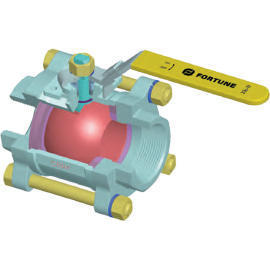Ball Valve
 A ball valve (like the butterfly valve, one of a family of valves called quarter turn valves) is a valve that opens by turning a handle attached to a ball inside the valve. The ball has a hole, or port, through the middle so that when the port is in line with both ends of the valve, flow will occur. When the valve is closed, the hole is perpendicular to the ends of the valve, and flow is blocked. The handle position lets you "see" the valve's position.
A ball valve (like the butterfly valve, one of a family of valves called quarter turn valves) is a valve that opens by turning a handle attached to a ball inside the valve. The ball has a hole, or port, through the middle so that when the port is in line with both ends of the valve, flow will occur. When the valve is closed, the hole is perpendicular to the ends of the valve, and flow is blocked. The handle position lets you "see" the valve's position.
Ball valves are durable and usually work to achieve perfect shutoff even after years of disuse. They are therefore an excellent choice for shutoff applications (and are often preferred to globe valves and gate valves for this purpose). They do not offer the fine control that may be necessary in throttling applications but are sometimes used for this purpose.
Ball valves are used extensively in industry because they are very versatile, pressures up to 10,000 psi, temperatures up to 200 Deg C. Sizes from 1/4" to 12" are readily available They are easy to repair, operate manually or by actuators.
The body of ball valves may be made of metal, plastic or metal with a ceramic center. The ball is often chrome plated to make it more durable.
The body of ball valves may be made of metal, ceramic, or plastic. The ball may be chrome plated to make it more durable.
There are three general types of ball valves: full port, standard port, and reduced port.
- A full port ball valve has an oversized ball so that the hole in the ball is the same size as the pipeline resulting in lower friction loss. Flow is unrestricted, but the valve is larger.
- A standard port ball valve is usually less expensive, but has a smaller ball and a correspondingly smaller port. Flow through this valve is one pipe size smaller than the valve's pipe size resulting in slightly restricted flow.
- In reduced port ball valves, flow through the valve is two pipe sizes smaller than the valve's pipe size resulting in restricted flow.
- A trunnion ball valve has a mechanical means of anchoring the ball at the top and the bottom.
Manually operated ball valves can be closed quickly and thus there is a danger of water hammer. Some ball valves are equipped with an actuator that may be pneumatically or motor (electric) operated. These valves can be used either for on/off or flow control. A pneumatic flow control valve is also equipped with a positioner which transforms the control signal into actuator position and valve opening accordingly.